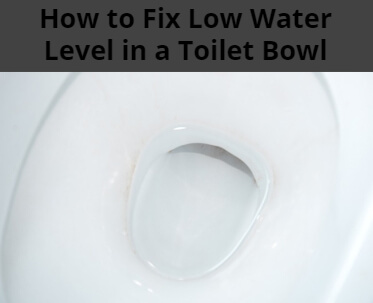Toilet Water Level Low
 Is your toilet’s water level lower than usual? Is your toilet bowl not filling with water after flushing?
Is your toilet’s water level lower than usual? Is your toilet bowl not filling with water after flushing?
This common occurrence has a few potential culprits, and luckily, most are easy to adjust with a little plumbing know-how and a few minutes of your time.
6 Reasons Your Toilet Water Level is Low & How to Fix It
Toilet water levels can be low for a variety of reasons, but the most common causes are partial clogs, leaks, and damaged or faulty parts. Here are some solutions for each problem:
Read on to learn more about these common reasons for the low water level in your toilet bowl and how to fix it.
1. Partial Toilet Clog
A partial clog in your toilet could cause water to siphon out of the toilet bowl. The easiest way to determine if a partial clog is causing your toilet’s low water level is to flush the toilet and observe. Does the water level rise to the top of the toilet and then slowly go down? If so, you may have an obstruction or partial clog in your toilet trap.
SOLUTION: Use a toilet plunger to remove or break up the clog.
Don’t have a plunger handy? Check out our article: 3 Ways to Unclog a Toilet Without a Plunger
2. Leaks
A leak in the toilet tank or bowl not only causes the water level to drop but can also waste water if the toilet constantly runs to restore water levels. To check for leaks, put food coloring in the tank and wait a few minutes. If the food coloring appears in the bowl, there is a leak. If you don’t see a leak, you may need to check the wax ring that seals the toilet to the floor. If the wax ring is damaged, you’ll need to replace it.
SOLUTION: To fix this, you can try tightening the bolts that hold the tank to the bowl or replacing the flapper valve, which is the part that controls the flow of water from the tank to the bowl or replacing the wax ring if that’s where the leak is.
3. Damaged Fill Tube
The most common reason your toilet bowl water level is low is a damaged fill tube. The fill tube is a small flexible plastic hose. It’s usually black or clear and connects to a vertical, wider plastic tube (called the overflow tube) within the toilet tank.
This small component allows water to flow into the toilet bowl each time the toilet is flushed. However, over time, it can unclip from the overflow tube or succumb to general wear and tear. When this happens, the toilet tank fills with water and the valve shuts off the water flow before the bowl fills adequately.
SOLUTION: Lift the tank lid and visually inspect the fill tube to determine whether it has shifted or is damaged. If it’s in good condition but not connected to the overflow tube, place it back into the cylinder. If it’s damaged and cannot be adjusted or fixed, replace the fill tube.
4. Damaged Fill Valve
Your toilet’s fill valve is responsible for refilling the tank after you flush the toilet. It’s generally a white tube that connects to the water supply at the bottom of the toilet and has a shutoff valve at the top. When working properly, an air-filled ball or cup will float to the top of the tank and shut off the valve once the water reaches a certain height. However, fill valves will wear out over time, so if your fill valve is damaged and not working properly, you can purchase a replacement at any hardware store.
SOLUTION: Inspect the fill valve and adjust or replace it if necessary.
5. Cracked Toilet Bowl
Although cracks in the toilet bowl are rare, they can happen. Water will leak onto the floor when there’s a crack in the lower toilet bowl. As a result, the water levels in your toilet bowl will be noticeably lower.
SOLUTION: Replace the toilet or attempt to seal the crack.
6. Blocked Sewer Vent Line
Although rare, low toilet bowl water levels can be caused by an issue with the sewer vent line.
The sewer vent line runs through the wall in your bathroom and out of your home’s roof. This important component of your plumbing system removes sewer gases when the toilet flushes. However, the water level can be affected if there is no free airflow through the vent line.
Possible reasons for blockage include:
- Bird’s nest
- Dead rodent
- Leaves, small branches, and other debris falling onto your roof
SOLUTION: Remove the debris from the roof and shine a flashlight into the vent. If you see a clog, insert a plumber’s snake to dislodge it. Call a plumber if that doesn’t work or you don’t see a blockage.